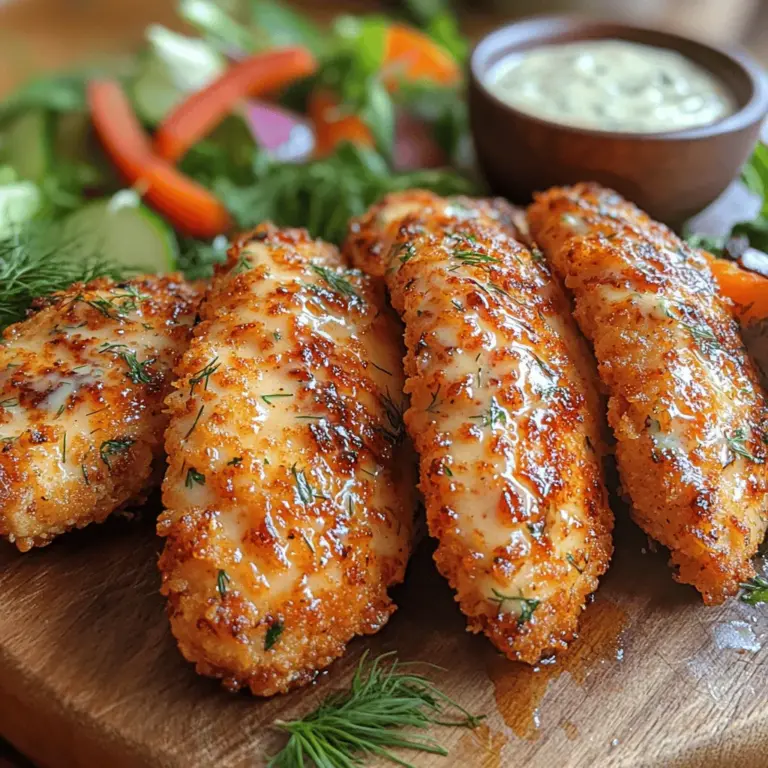In the world of comfort food, few dishes can rival the allure of crispy chicken tenders. This Crispy Buttermilk Ranch Chicken Tenders recipe brings together the savory flavors of buttermilk, ranch seasoning, and a delightful crunch that will satisfy your taste buds and leave everyone asking for more. Whether you’re looking for a quick weeknight dinner or a standout dish for your next gathering, these tenders are not just easy to make but also a guaranteed crowd-pleaser. The combination of tender chicken, a creamy marinade, and a crispy exterior creates a perfect balance of flavors and textures that appeals to both kids and adults alike.
In this article, we will delve into the intricacies of preparing these delectable chicken tenders, including insights into the key ingredients, essential cooking techniques, and creative serving suggestions that can elevate your dining experience. Let’s dive in and explore what makes this dish a beloved staple in many households.
Understanding the Key Ingredients
Every great recipe begins with quality ingredients, and this Crispy Buttermilk Ranch Chicken Tenders recipe is no exception. Each component plays a vital role in achieving the perfect flavor and texture, ensuring that your chicken tenders are not only delicious but also memorable. Here, we will break down the essential ingredients that make this dish shine.
The Role of Buttermilk in Marination
Buttermilk is a critical ingredient in this recipe, serving as the foundation for the marinade. Its acidity helps to tenderize the chicken, breaking down proteins and resulting in meat that is juicy and flavorful. The tangy flavor of buttermilk also infuses the chicken with a subtle richness that pairs beautifully with the spices and seasonings.
When marinating chicken tenders in buttermilk, it’s essential to allow enough time for the chicken to soak up the flavors. A minimum of two hours is recommended, but for the best results, an overnight marination is ideal. This extended time allows the buttermilk to work its magic, ensuring each bite is bursting with flavor and tenderness.
The Spice Profile: Garlic Powder, Onion Powder, and Dill
A key element to achieving a well-rounded flavor in your chicken tenders is the use of spices. Garlic powder and onion powder are staples in savory cooking, providing a depth of flavor that complements the chicken beautifully. These spices add a savory note that enhances the overall taste experience, making the tenders irresistible.
Dill, often associated with ranch seasoning, brings a fresh herbaceous quality to the dish. It adds brightness and complexity, making every bite more exciting. The combination of these three spices creates a robust flavor profile that elevates the chicken tenders from ordinary to extraordinary.
Paprika: Adding Color and Flavor
Paprika is not just a vibrant color enhancer; it also contributes a unique flavor that can range from sweet to smoky, depending on the type you choose. In this recipe, a sweet or smoked paprika can be used to impart a warm, earthy flavor that balances the richness of the buttermilk and the spices.
When selecting paprika, consider your personal preference. Smoked paprika adds a hint of depth and a subtle smokiness, while sweet paprika enhances the overall sweetness of the dish. Regardless of the type you choose, paprika is essential for achieving that appealing golden-brown color that makes these chicken tenders visually enticing.
The Importance of Proper Seasoning
While the buttermilk and spices provide the foundation of flavor, seasoning with salt and black pepper is crucial for enhancing the overall taste of the chicken tenders. Salt not only amplifies the flavors of the other ingredients but also helps to draw moisture into the chicken, ensuring it remains juicy during cooking.
Black pepper adds a gentle kick, balancing the richness of the buttermilk and spices while providing a touch of warmth. It’s important to season the chicken thoroughly, both in the marinade and in the breading process, to ensure that every bite is as flavorful as possible.
Preparation Techniques for the Best Results
Preparing crispy chicken tenders may seem straightforward, but a few key techniques can make all the difference in achieving the desired texture and flavor. Below, we outline the essential steps to prepare your chicken tenders like a pro.
Marinating the Chicken: A Step-by-Step Guide
1. Choose Your Chicken: Start with high-quality chicken tenders. If you can’t find tenders, you can easily use boneless, skinless chicken breasts cut into strips.
2. Prepare the Marinade: In a large mixing bowl, combine buttermilk, garlic powder, onion powder, dill, paprika, salt, and black pepper. Whisk until well combined.
3. Marinate the Chicken: Add the chicken tenders to the marinade, ensuring they are fully submerged. Cover the bowl with plastic wrap or transfer the mixture to a resealable bag. Refrigerate for at least two hours, or preferably overnight.
4. Remove from the Marinade: When ready to cook, remove the chicken from the refrigerator. Allow it to sit at room temperature for about 15 minutes before cooking. This helps the chicken cook evenly.
Setting Up a Breading Station
Creating an efficient breading station is key to achieving a crispy coating on your chicken tenders. Here’s how to set it up:
1. Gather Your Ingredients: You will need all-purpose flour, eggs, and breadcrumbs (panko or regular) for the breading. Place each ingredient in separate shallow dishes.
2. Season the Flour: In the flour dish, add a pinch of salt and pepper. This will ensure that the coating is well-seasoned.
3. Prepare the Eggs: In a bowl, whisk the eggs until well combined. This will act as the binding agent for the breadcrumbs.
4. Prepare the Breadcrumbs: In another shallow dish, place the breadcrumbs. For added flavor, you may mix in some dried herbs or additional spices if desired.
Coating the Chicken Tenders
A three-step coating process is essential for achieving the ultimate crispy texture. Here’s how to do it:
1. Dredge in Flour: Take a marinated chicken tender and dredge it in the seasoned flour, shaking off any excess flour. This initial coating helps the egg adhere better.
2. Dip in Egg: Next, dip the floured chicken tender into the whisked eggs, ensuring it is fully coated.
3. Coat in Breadcrumbs: Finally, place the chicken tender in the breadcrumbs. Press gently to ensure the breadcrumbs adhere well, covering the entire surface. Repeat this process with all the chicken tenders.
By following these steps, you’ll create a crispy, flavorful coating that will make your chicken tenders truly irresistible.
Frying to Perfection
The frying process is where these chicken tenders truly come to life, transforming them into golden-brown, crispy delights. While this part of the recipe will be elaborated on in the next section, it’s essential to prepare your frying setup in advance.
Choose your frying method, whether you opt for deep-frying or pan-frying, and ensure you have the right equipment on hand. The temperature of the oil is crucial to achieving that perfect crispy exterior while keeping the chicken tender and juicy inside.
With these preparation techniques in place, you are now ready to move on to the frying process and enjoy the delicious results of your hard work. Stay tuned as we explore how to fry your tenders to perfection, ensuring they are crispy on the outside and tender on the inside.
{{image_1}}
Choosing the Right Oil for Frying
Frying chicken tenders to perfection requires not only skill but also the right choice of oil. The oil you use impacts both the flavor of the chicken and the healthiness of the dish. Here are some popular options for frying chicken tenders:
1. Canola Oil: This is a favorite among many cooks because of its neutral flavor. Canola oil has a high smoke point of around 400°F (204°C), making it ideal for frying. It’s also lower in saturated fats compared to other oils.
2. Peanut Oil: Known for its slightly nutty flavor, peanut oil has a high smoke point of approximately 450°F (232°C). This oil is an excellent choice for achieving a crispy crust while adding a subtle flavor that complements the chicken.
3. Vegetable Oil: Often a blend of different oils, vegetable oil is another neutral option that works well for frying. It typically has a smoke point around 400°F (204°C) and is widely available.
4. Olive Oil: While extra virgin olive oil has a lower smoke point (around 375°F or 191°C), refined olive oil can tolerate higher temperatures. Its distinct flavor can add a gourmet touch to your chicken, but be cautious as it may not hold up as well for deep frying.
5. Coconut Oil: With a smoke point of about 350°F (177°C), coconut oil offers a unique flavor profile. It’s solid at room temperature, which may require melting before use. While it can impart a delightful taste, it’s best used sparingly due to its saturated fat content.
Choosing the right oil is crucial for flavor and texture. Opt for oils with higher smoke points to prevent burning and ensure your chicken tenders come out crispy and golden brown.
Determining the Ideal Frying Temperature
Maintaining the right oil temperature is essential for frying chicken tenders. If the oil is too cool, the chicken will absorb more oil, leading to greasy tenders. Conversely, if the oil is too hot, the outside will cook quickly while the inside remains raw.
The ideal frying temperature for chicken tenders is between 350°F and 375°F (175°C – 190°C). Here’s how to ensure you’re frying at the right temperature:
– Use a Deep-Fry Thermometer: This tool is invaluable for maintaining accurate temperatures. Attach it to the side of your pot to monitor the oil’s temperature throughout the cooking process.
– Test with a Small Piece of Chicken: Before frying the entire batch, test the oil’s readiness by dropping a small piece of chicken into the oil. If it sizzles immediately and rises to the surface, the oil is ready. If it sinks and doesn’t sizzle, allow the oil to heat more.
– Monitor Throughout Cooking: The temperature of the oil can fluctuate as you add chicken. Adjust the heat accordingly to maintain the ideal frying range.
By ensuring the oil is at the right temperature, you can achieve perfectly crispy chicken tenders that are cooked through and bursting with flavor.
Frying Techniques: Batch Cooking for Consistency
When frying chicken tenders, it’s best to work in batches to ensure even cooking and maintain the oil temperature. Here are some tips to fry your tenders effectively without compromising quality:
– Don’t Overcrowd the Pan: Adding too many chicken tenders at once can lower the oil temperature, resulting in soggy tenders. Fry in small batches, allowing enough space between each piece for the oil to circulate.
– Use a Slotted Spoon: As the tenders cook, use a slotted spoon to gently turn them. This helps ensure even browning on all sides and prevents sticking.
– Drain Excess Oil: Once the tenders are golden brown and cooked through, remove them from the oil and place them on a plate lined with paper towels. This will absorb excess oil and keep the tenders crispy.
– Keep Cooked Tenders Warm: If you’re frying multiple batches, keep the cooked tenders warm in an oven set to 200°F (93°C). This prevents them from cooling down and helps maintain their crispiness until serving.
By following these frying techniques, you can achieve consistent and delicious results with your crispy buttermilk ranch chicken tenders.
Serving Suggestions: Elevating Your Meal
Once your chicken tenders are cooked to perfection, it’s time to elevate the meal with thoughtful serving suggestions. Here’s how to make your dish shine:
Pairing Dipping Sauces with Chicken Tenders
Dipping sauces are a fun way to add flavor and variety to your chicken tenders. Here are some popular options that pair beautifully with the crispy buttermilk ranch chicken tenders:
1. Classic Ranch Dressing: This is a natural choice, enhancing the ranch flavor already present in the tenders. Its creamy texture contrasts wonderfully with the crispy coating.
2. Buffalo Sauce: For those who enjoy a spicy kick, buffalo sauce adds heat and tanginess. Just toss the cooked tenders in the sauce or serve it on the side for dipping.
3. Honey Mustard: The sweetness of honey combined with the tang of mustard creates a delightful contrast to the savory tenders. This sauce is great for those who prefer a milder flavor.
4. Barbecue Sauce: Smoky and sweet, barbecue sauce adds depth to the chicken tenders. It’s perfect for those who love a Southern flair.
5. Sriracha Aioli: For a gourmet touch, whip up a sriracha aioli by mixing mayonnaise, sriracha, and a bit of lemon juice. This creamy, spicy sauce pairs excellently with the tenders.
Adding Fresh Sides for a Balanced Meal
To create a well-rounded meal, consider serving your chicken tenders with fresh sides. Here are some suggestions that enhance both flavor and nutrition:
– Coleslaw: A classic side that adds crunch and complements the richness of the chicken. It can also be made healthier with a yogurt-based dressing.
– Garden Salad: A simple salad with mixed greens, cherry tomatoes, cucumbers, and a light vinaigrette can provide a refreshing contrast to the crispy tenders.
– Roasted Vegetables: Seasonal roasted vegetables like carrots, zucchini, and bell peppers can add color and nutrients to your plate.
– Corn on the Cob: Grilled or boiled corn on the cob is a summer favorite that pairs well with fried chicken.
– Sweet Potato Fries: For a twist, serve the tenders with sweet potato fries. Their sweetness complements the savory chicken, and they offer a nutritious alternative to regular fries.
Creative Presentation Ideas
Presentation plays a crucial role in making your meal appealing. Here are some creative plating strategies to consider:
– Use a Large Platter: Arrange the chicken tenders on a large platter with dipping sauces in small bowls around them. This encourages sharing and creates a vibrant centerpiece.
– Garnish with Fresh Herbs: Sprinkling chopped parsley or cilantro over the tenders adds a pop of color and freshness.
– Incorporate Colorful Sides: Arrange your sides in a way that showcases their colors. For instance, place a bright garden salad next to the golden tenders for visual contrast.
– Serve in Baskets: For a casual presentation, serve the tenders in small baskets lined with parchment paper. This adds a rustic touch and makes for easy serving.
– Create a Themed Meal: If you’re serving chicken tenders for a family gathering or party, consider a theme. For example, a picnic theme could include checkered tablecloths and mason jars for drinks.
Nutritional Considerations
As with any dish, understanding the nutritional content of crispy buttermilk ranch chicken tenders can help you make informed choices. Here’s a breakdown of the caloric content and some healthier alternatives to consider.
Caloric Breakdown of Crispy Buttermilk Ranch Chicken Tenders
A standard serving of crispy buttermilk ranch chicken tenders (approximately 4-5 tenders) contains the following nutritional values:
– Calories: 400-500 (depending on the frying method and portion size)
– Protein: 30-35 grams
– Fat: 20-30 grams (mostly from the frying oil)
– Carbohydrates: 30-40 grams
These values can vary based on the specific ingredients used and the frying method employed. It’s important to be mindful of portion sizes, especially if you’re pairing the tenders with rich dipping sauces or sides.
Healthier Alternatives for Ingredients
For those looking to reduce calories or cater to dietary restrictions, consider these healthier alternatives:
– Baking Instead of Frying: Instead of frying, bake the chicken tenders at 425°F (220°C) for about 20-25 minutes. Coat them in a light layer of oil or cooking spray for a crispy finish without the excess fat.
– Gluten-Free Options: Use gluten-free breadcrumbs or almond flour instead of traditional breadcrumbs to make gluten-free chicken tenders. This allows those with gluten sensitivities to enjoy the dish.
– Low-Fat Buttermilk: Substitute regular buttermilk with low-fat or non-fat buttermilk to reduce calorie content while still maintaining creaminess.
– Vegetable Dipping Options: Serve your tenders with fresh vegetable sticks (like carrots and celery) alongside the dipping sauces to add crunch and nutrition without the added calories of fried sides.
Conclusion
Crispy buttermilk ranch chicken tenders are more than just a meal; they are an experience that brings families and friends together. With the perfect blend of flavors and textures, this dish is sure to become a favorite in your household. By understanding the ingredients, mastering the preparation techniques, and serving these tenders creatively, you can elevate your cooking game and impress your guests. The joy of cooking is not just in the eating but also in the process, and this recipe encapsulates that beautifully. Enjoy your culinary journey as you create these crispy delights!



